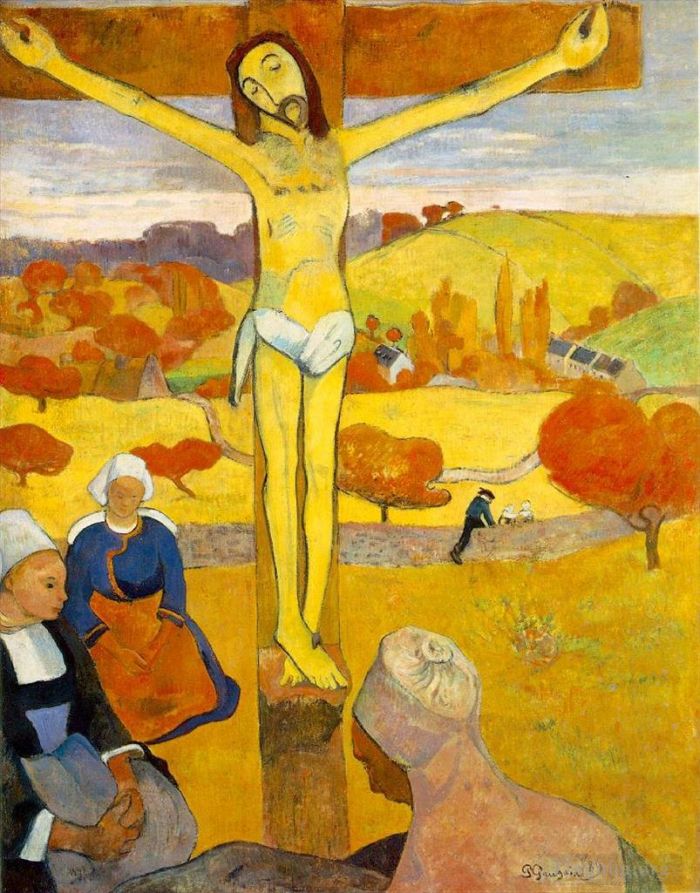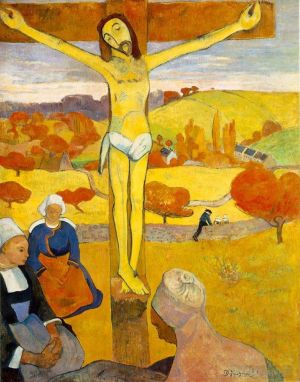The Yellow Christ
Paul Gauguin
- Price: Price on Request
- Art Type: Oil Painting
- Size:
- English Comments: 0
- International Comments: 0
- Creating Date:
- Introduction and Works of Paul Gauguin >>
Work Overview
- The Yellow Christ
Artist Paul Gauguin
Year 1889
Medium Oil on canvas
Dimensions 91.1 cm × 73.4 cm (35.9 in × 28.9 in)
Location Albright-Knox Art Gallery
The Yellow Christ (in French: Le Christ jaune) is a painting executed by Paul Gauguin in 1889 in Pont-Aven. Together with The Green Christ, it is considered to be one of the key works of Symbolism in painting.
Gauguin first visited Pont-Aven in 1886. He returned to the village in early 1888 to stay until mid-October, when he left to join Vincent van Gogh in Arles, for little more than two months. Early in 1889, Gauguin was back to Pont-Aven to stay there until spring 1890. It was only for a short visit in summer 1889 to Paris to see the Exposition universelle and to arrange the Volpini Exhibition that Gauguin interrupted this sojourn. Soon after his return to Pont-Aven he painted The Yellow Christ:
The Yellow Christ is a symbolic piece that shows the crucifixion of Christ taking place in nineteenth-century northern France as Breton women are gathered in prayer. Gauguin relies heavily on bold lines to define his figures and reserves shading only for the women. The autumn palette of yellow, red and green in the landscape echoes the dominant yellow in the figure of Christ. The bold outlines and flatness of the forms in this painting are typical of the cloisonnist style.
A study for The Yellow Christ in pencil is preserved in the Thyssen-Bornemisza Museum, and a version in watercolor is in the collection of the Art Institute of Chicago, gift of Elizabeth F. Chapman.
The Symbolists, who emerged during the 1880s, were weary of modern society and sought escape from reality. They began to express their dreams and visions through vivid colors, forms, and compositions. As part of this pursuit, Paul Gauguin left Paris altogether in the late 1880s. During the summer of 1886, he visited the small village of Pont-Aven in Brittany, France, and became fascinated with its history, folklore, and rituals. It was there that Gauguin painted numerous scenes, including “The Yellow Christ.” The central figure of this painting is based on a seventeenth-century painted wooden crucifix that hangs in the nearby Trémalo Chapel. Gauguin painted Christ in a cloying yellow against a dark brown cross in a vibrant fall landscape. Gauguin said he chose the color yellow to convey how he felt about the isolated life and piety of the peasants, several of whom are pictured here dressed in their distinctive regional costume and kneeling at the foot of the cross during the evening hour of Angelus—a Catholic prayer recited daily at 6 am, noon, and 6 pm. In Brittany, the autumn harvest possessed deep spiritual significance, as grain was believed to undergo a process parallel to the religious cycle of Christian life—birth, life, death, and rebirth. The simplicity and primitive directness of the region’s peasants greatly appealed to Gauguin, who made his famous protest against Western sophistication by exiling himself to the South Seas not long after completing this painting. Brittany was Gauguin’s first step away from Paris, and his works completed during this time mark a major stylistic departure from Impressionism.
- Copyright Statement:
All the reproduction of any forms about this work unauthorized by Singing Palette including images, texts and so on will be deemed to be violating the Copyright Laws.
To cite this webpage, please link back here.
- >> English Comments
- >> Chinese Comments
- >> French Comments
- >> German Comments
- >>Report
- Ceramic Vase with a Caricature Self Portrait
- Ceramic vase with Tahitian Gods Hina and Tefatou
- Girl with a Fan
- Te avae no Maria Month of Maria
- Cattle Drinking
- The Call
- Ford Running Away
- Horse on Road Tahitian Landscape
- Three Tahitian Women Against a Yellow Background
- Ta Matete We Shall Not Go to Market Today
- The Seine in Paris between the Pont d Lena and the Pont de Grenelle
- Yellow Hay Ricks Fair Harvest
- Te Vaa The Canoe
- The Seine at the Pont d Iena Snowy Weather
- Day of the God (Mahana No Atua)
- Barbarous Tales
- Fatata te moua At the Foot of a Mountain
- Te Tiare Farani Bouquet of Flowers
- Aube the Sculptor and His Son
- Apple Trees in Blossom
- Baby The Nativity
- Vahine no te vi Woman with a Mango
- Les Alyscamps Arles
- Mandolina and Flowers
- Breton Shepherdess
- Aha oe feii Are You Jealous
- Spirit of the Dead Watching
- The Meal The Bananas
- Mimi and Her Cat
- Tahitian Women On the Beach
- Vahine no te tiare Woman with a Flower
- Joyeusete Arearea
- Siesta
- Bonjour Monsieur Gauguin
- Adam and Eve
- Fatata te miti Near the Sea
- Matamoe Landscape with Peacocks
- The Alyscamps
- The Yellow Christ
- Te Tamari No Atua Nativity
- Madame Alexandre Kohler
- Sunflowers
- Fruits
- Tahitian Landscape
- Piti Teina Two Sisters
- Les Parau Parau Conversation
- Horsemen on the Beach
- Two Breton Women on the Road
- The Fisherwomen of Tahiti
- Merahi metua no Tehamana Ancestors of Tehamana
- La Belle Angele Portrait of Madame Satre
- Te Faaturuma Brooding Woman
- Study of a Nude Suzanne Sewing
- Ia Orana Maria Hail Mary
- Vairumati
- Bouquet of Flowers with a Window Open to the Sea Reverse of Hay Making in Brittany
- Portrait of a Woman with Cezanne Still Life
- Portrait of Gauguin s Daughter Aline
- Mother and Daughter
- Eve Don t Listen to the Liar
- Harvesting of Grapes at Arles Miseres humaines
- Palm Trees on Martinique
- Effect of Snow
- Tahitian Idyll
- Haystacks in Brittany
- Woman Holding a Fruit (Where Are You Going or Eu haere ia oe)
- Taperaa Mahana
- When Will You Marry
- The Four Breton Girls c
- Motherhood Women on the Shore
- Portrait of the Artist with the Idol
- Whats New? (Parau Api or Two Women of Tahiti)
- Hay Making in Brittany
- Still Life with Mangoes
- The Cellist Portrait of Upaupa Scheklud
- Te Pape Nave Nave Delectable Waters
- Man Picking Fruit from a Tree
- 5 Horsemen on the Beach
- At the Pond
- The Schuffenecker Family
- Nevermore O Taiti
- Aita Tamari vahina Judith te Parari Annah the Javanese
- Landscape
- Paysannes bretonnes Breton peasant women
- Still Life with Fan
- Ondine
- Where Do We Come From? What Are We? Where Are We Going?
- Black Pigs
- Rave te hiti aamy The Idol
- Tarari maruru Landscape with Two Goats
- Self portrait
- The Swineherd Brittany
- Bouquet
- Vision of the Sermon (Jacob Wrestling with the Angel)
- Washerwomen at Pont Aven
- Women from Arles in the Public Garden the Mistral
- And the Gold of Their Bodies Et l or de leurs corps
- Scenes from Tahitian Life
- Still Life with Mandolin
- No te aha oe riri Why Are You Angry
- Breton Girls Dancing Pont Aven
- Two Tahitian Women
- Pastorales Tahitiennes
- Parau na te varua ino Words of the devil
- Huts under Trees
- Self Portraits
- Tahitian Woman c
- The Great Buddha
- Breton Landscape The Moulin David
- Night Cafe at Arles
- Portrait of William Molard
- Bouquet of Flowers
- Eiaha Ohipa Not Working
- Three Tahitians
- Self Portrait c
- Van Gogh Painting Sunflowers
- Madeleine Bernard
- Nave Nave Moe Miraculous Source
- Breton Village in Snow
- Portrait de l artiste Self portraitc
- Portrait of Mother
- Caricature Self Portrait
- Nave Nave Moe Sacred Spring
- Vairaumati tei oa Her Name is Vairaumati
- At the Window A la fenetre
- Self Portrait c1894
- Te arii vahine The King s Wife
- Portrait of the Artist with the Yellow Christ
- The White Horse
- Self Portrait 1896
- Be in Love and You Will Be Happy
- Nirvana Portrait of Meyer de Haan
- M Loulou
- Floral and Vegetal Motifs
- Musique barbare
- The Messengers of Oro
- Tahitian Eve c
- Head of a Negress
- Still Life with Three Puppies2
- Words of the Devil c
- Head of a Woman
- Te Arii Vahine Queen
- Study for the Bathers
- Breton Girls Dancing
- Still Life with Three Puppies1
- Tahitian Woman in a Landscape
- Study for La perte de Pucelage The Loss of Virginity
- Pape Moe Mysterious Water









 Singing Palette
Singing Palette